
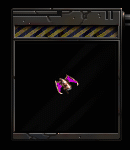
("Missile")
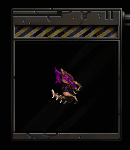
("Snake")
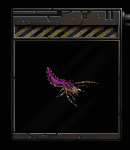
("Scorpion")
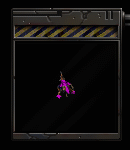
("Leaper")
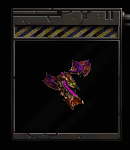
("Dragon")
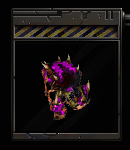
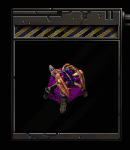
("Skulker")
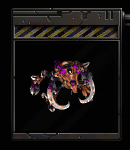
("Elephant")

| Name | Picture |
Designation | Description | Size |
|---|---|---|---|---|
| Egg | ? |
Intermediate Stage | When the creatures mature from the Larval state, they retreat into the Egg form for 2-6 days, emerging as a fully-functional member of one of the subspecies. Probable final form can be determined by PRIS and densitometer observation. | 3' high |
| Cerebrate |

|
Central Brain |
Every Zerg Swarm has one - and only
one - Cerebrate at its' centre. This creature is the brains and motivation
behind the entire infestation, directing the operations of all its' minions
by means of a psionic waveband unknown to other psionic creatures. Immobile
and physically helpless, it relies on its' spawn and its' wits to do everything
for it, and has no attack of its' own. It does, however, have an extreme
form of the Zerg regeneration ability, and is effectively immortal and invulnerable,
except to certain forms of Protoss High Templar energy. |
100' across |
| Scourge | 
|
Anti-air defence ("Missile") |
Small, extremely fast-moving flyer, propelled by internal jet system. Intelligence minimal. Attacks any moving thing non-Zerg that rises above 140' and below 2,500' by ramming, producing an explosion. Burrows when not required. | 2' long |
| Hydralisk |

|
Heavy Infantry ("Snake") |
Slower moving fighter than the Leaper, has missile attack as well as boneblades. Armoured from the front. Intelligence higher than most forms. Evidence of intentional cruelty. Does not appear to feed in any way; this form is purely designed for warfare. Burrows. Regenerates. | 7' high; 12' long in total. |
| Defiler |

|
Sneak Attack ("Scorpion") |
Can emit a deadly cloud of corrosive
gas, and plant some form of "seeds" in unprotected humans or Protoss which
hatch into two small Zerg creatures, killing the host. Burrows and regenerates.
Hides. Has minimal attack with front claws. Sneaky, may be quite intelligent.
|
15' long |
| Zergling | 
|
Light infantry ("Leaper") |
Small, extremely fast ground fighter. Can leap 3x body length to attack. Armoured top surface. Equipped with boneblades. Some intelligence. Does not feed. Burrows. Regenerates. | 3' high; 7' long total. |
| Mutalisk |

|
Attack flyer ("Dragon") |
Medium sized winged flyer. Attacks airborne or ground targets with acid/venom spittle. Moderate intelligence. Does not feed or burrow. Regenerates. | 10' long; 20' wingspan |
| Overlord | 
|
Troop carrier | Large, blimp-like flyer, capable of holding other types in its' body and transporting them. Also appears to have senses similar in ability to mechanical sensors, and possibly some form of control over the other types. Does not feed or burrow. Regenerates. | 50' diameter |
| Queen |

|
?? ("Skulker") |
Large, slow flyer. Secretive and shy, skulks and hides. Capabilities unknown. | 20' diameter |
| Ultralisk |

|
Heavy Infantry ("Elephant") |
Massive ground monster, slow and enormously strong, armoured like a tank. Not especially intelligent. Very large boneblades capable of piercing starship armour. Does not feed or burrow. Regenerates slowly. | 20' high, 30' long. |
| Larva | 
|
Early stage | Only dead ones retrieved so far. This is the basic form; when other forms are required, these transform into the Egg form and thence into what's needed. | 2' long |
| Structure |
Designation | Description | Size |
|---|---|---|---|
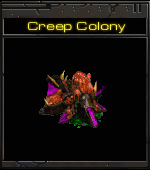
|
Structure support |
The basic factories that generate the Creep all Zerg structures grow on, these are where the hapless inhabitants of captured worlds are processed into the biomass which makes up the Swarm. They have no combat capabilities. | 30' high |

|
Defensive installation - ground
defence ("The Mound in the Forest") |
Evolved from a Creep Colony, the Sunken colony
can attack through the ground, shooting powerful roots deep under the surface
to emerge under the feet of hapless attackers. |
15' high |

|
Defensive installation - air
defence |
Evolved from a Creep Colony, the Spre Colony
defends the Zerg base against air attack, shooting energy blasts that can
bring down quite large craft. It has no attack against land forces. |
50' high |
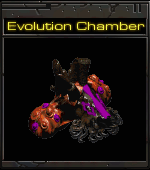
|
Genetic Booster |
Once this structure is installed on a section
of Creep, more advanced genetic material is available to the structures
sharing that Creep, allowing them to develop into more advanced forms and
produce better creatures. |
100' across |
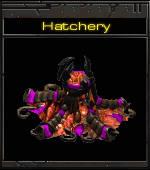
|
Basic creature production facility |
The Hatchery is the core of basic Zerg
creature production. Larvae are slowly produced and stored in the Hatchery;
once the Cerebrate decides what breeds it needs, the larvae retreat into eggs
and metamorphose into the species required. These then leave the Hatchery.
|
200' across |
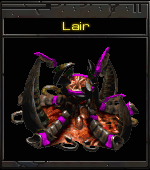
|
Advanced creature production
facility |
The mature form of the Hatchery, the Lair produces
more larvae and gestates its' eggs faster. It's tougher than the Hatchery
and better armoured. |
300' across |

|
Advanced creature production
facility |
Developed from the Lair, the Hive is another
advance in speed and volume of Zerg creature production. A Hive is almost
as hard to kill as a Cerebrate, though once killed they do stay dead. |
500' across |
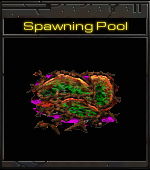
|
Genetic code storage |
The Spawning Pool maintains and contributes
the necessary genetic codes for the production of Zerglings. |
|

|
Genetic code storage |
The Hydralisk Den maintains and contributes
the necessary genetic codes for the production of Hydralisks. |
|
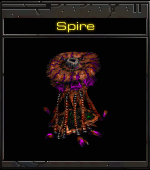
|
Genetic code storage |
The Spire maintains and contributes the necessary
genetic codes for the production of Scourges and Mutalisks. |
|
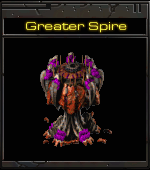
|
Genetic code storage |
The mature form of the Spire, the Greater Spire
allows flying Zerg such as the Mutalisk to metamorphose again into more advanced
and specialized forms. |
|

|
Genetic code storage |
The Queen's Nest maintains and contributes the
necessary genetic codes for the production of the so far mysterious Queen
breed of Zerg. |
|
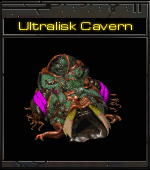
|
Genetic code storage |
The Ultralisk Cavern maintains and contributes
the necessary genetic codes for the production of Ultralisks. |
|
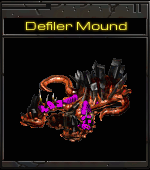
|
Genetic code storage |
The Defiler Mound maintains and contributes
the necessary genetic codes for the production of Defilers. |
|
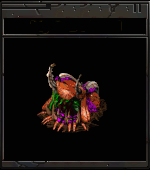
|
?? |
A very rare Zerg structure, not completely analysed
by the Protoss, its' function is currently unknown. |